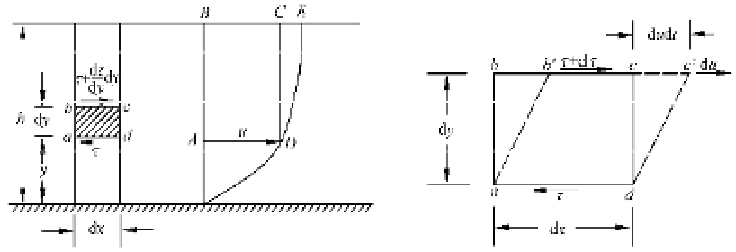Environmental Engineering Reference
In-Depth Information
about 0.7 m, the velocity changed from 0.8 to 1.5 m/s as the bed form developed from dunes to flat and
antidunes, and the unit discharge, thus, changed correspondingly. Furthermore, since different discharges
can occur for a given value of depth and slope, so also can different water depths occur for a given
discharge and slope. Obviously, these phenomena are difficult to comprehend because they cannot be
explained in terms of any of the existing formula for flow resistance.
In this situation, only after the intrinsic relation between the roughness and the flow has been determined,
can one understand resistance in alluvial streams. The roughness of an alluvial stream has various
components and each component has its own relation to the flow. Hence, a rational approach should be
first to clearly demonstrate how each component functions for various conditions of flow, and then to
determine how these components combine and function to provide a comprehensive picture of roughness
for an alluvial stream. In the next section the resistance or roughness of various components in alluvial
rivers is discussed.
Bed form adjustment represents a response to changing discharge and sediment load conditions during,
for example, the passage of a flood wave, although there is always a lag between a change of flow and a
corresponding change of bed form because of the redistribution of sediment involved. That lag, which
has a spatial as well as a temporal dimension, will increase with the size of both the bed form and the
river (Allen, 1983). Under certain conditions a given discharge can be transmitted at two or more
different depths and velocities, depending on the type and size of bed form produced. Bed configuration
in sand-bed streams is one of the most adjustable components of channel morphology, with the potential
for regulating short-term interactions between hydraulic variables.
5.1.5 Resistance
Water flows in an open channel only if its energy gradient slopes downward in the direction of flow. For
uniform flow, the water surface slope,
s
w
, and the channel bed slope,
s,
are the same and equal to the
energy gradient,
J
, which denotes the energy loss per unit weight of water in overcoming resistance as it
flows a unit distance in the channel. All the lost energy is finally transformed into thermal energy. To
study the resistance in alluvial rivers is essentially to study the mechanism of the transfer of mechanical
energy into thermal energy.
Figure 5.17 shows the forces acting on a water element in steady and uniform open channel flows. In
this case, the mean velocity does not change from cross section to cross section. The flow energy comes
totally from the potential energy. For the potential energy of each point in the water body, a small part
transforms into thermal energy at any given location due to the viscosity of water, but most is transmitted
to the boundary by the shear stress and transformed into turbulent kinetic energy. In the transformation, a
portion of the energy is lost, and the rest is transformed into kinetic energy of eddies. The eddies leave
the boundary, enter the main flow region and break up into smaller eddies. Then the energy of the smaller
Fig. 5.17
Forces acting on the water element
abcd
in two dimensional open channel flow (after Qian and Wan, 1983)


Search WWH ::

Custom Search